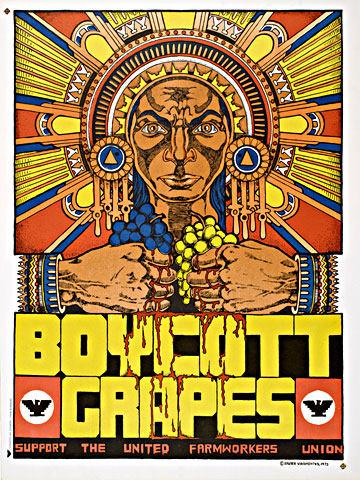Serigrafía: Chicano Art at the PMCA

The Pasadena Museum of California Art (PMCA) is presenting Serigrafía, an exhibit of thirty silkscreen prints created by twenty-three Chicano/Latino artists from the early 1970s to the present-day.
I am proud to announce that my own work is included in the exhibit. Opening on January 19, and running until April 20, 2014, the exhibit offers prints that are consummate examples of the Chicano Arts Movement as a stronghold of socially conscious art. The exhibit offers hand-made serigraphic prints that tackle social and political issues head-on, demonstrating that social realism in the visual arts is far from being on its last legs.
The PMCA’s press release for Serigrafía describes the exhibit: “Beginning in the late 1960s, graphic art created at and distributed by artist-led collectives, or centros, contributed significantly to the public discourse. Emerging in concert with the civil rights movement and demanding political and social justice for marginalized groups, these prints confront political, economic, social, and cultural issues on both a personal and a global level.”
PRINT magazine published The Enduring Power of Posters to Promote and Provoke, an illustrated interview with Carol A. Wells, Founder and Executive Director of the Center for the Study of Political Graphics, regarding Serigrafía at the PMCA. Serigrafia was first shown at Arte Americas in Fresno, CA (Sept. 8 – Nov. 3, 2013), and in upcoming exhibits will be shown at the San Francisco Public Library (July 20, 2014 – Sept. 7, 2014), and the Vacaville Museum – Nov. 9, 2014 – Jan. 4, 2015.
Serigrafía includes my 1980 silkscreen print, Nuclear War?!… There Goes My Career! That particular serigraph was initially produced as a Los Angeles street poster that expressed unease over the possibility of nuclear war with the Soviet Union. I must first preface remarks regarding my poster by mentioning my involvement in the late 1970s L.A. punk movement, which had enormous impact upon my political and aesthetic viewpoints. It was the apocalyptic vision of punk, the innately confrontational if sometimes humorous attitude of Chicanarte, combined with the fervently radical aesthetics of the French Situationists of the late 1950s and early 1960s, that led to the creation of Nuclear War?!… There Goes My Career!

As a piece of subversive art the print was an unqualified success at achieving its principal goal, that of helping to build popular support for nuclear disarmament. But in retrospect I feel somewhat ambivalent about the poster.
While it no doubt fulfilled its political objective, the poster’s aesthetic was an aberration in my development as an artist.
In essence I am a figurative realist draftsman, painter, and printmaker, and on a personal level the most fulfilling work I do is in that sphere. Years prior to creating the détourned graphic image I had made a firm commitment to figurative realism, and my body of work from the period bears this out.
That is the reason why this article includes other prints of mine created during the period represented by the show, works not exhibited in Serigrafía.
As I have argued over the years, Chicano art is a well-spring that may help to invigorate the long dormant genre of American social realist painting. While Serigrafía focuses exclusively upon silkscreen prints, it is worth noting that a number of the exhibiting artists are also painters (including this writer), and that Chicano/Latino print circles have long had very close association with the creation of public murals. If Serigrafía has a weakness as an exhibit, it is that it freezes its artists in a moment of time, and does not even hint at broader artistic production outside of poster making.

The PMCA is also presenting another important exhibit from January 19, to April 20, 2014, Picturing Mexico: Alfredo Ramos Martínez in California. I have been interested in Martínez for decades, as he is the artist that actually began the modernist school of Mexican social realism that came to hold Diego Rivera, David Alfaro Siqueiros, and other notable Mexican artists as unfaltering adherents. Yes, it all began with compañero Martínez. The artist holds special fascination for me as he came to live and work in my hometown of Los Angeles from 1929 to 1946 (where he died at age 73 in 1946). The beautiful and sympathetic portraits of Mexico’s poor and indigenous people that Martínez painted have long been an inspiration to me. The PMCA’s survey of his work is the very first museum exhibit of the works he created in California.
The Opening Reception for Serigrafía is Saturday, January 18, 2014, from 7 to 9 p.m. The exhibit runs from Jan. 19 to April 20, 2014. Museum admission is $7, free for PMCA members. The museum is located at: 490 East Union Street, Pasadena, CA 91101. Web: pmcaonline.org
Also not to be missed, on Sunday, March 2, 2014, at 3 p.m., Carol A. Wells, one of the curators for the exhibit, will present a lecture at the PMCA on the history of Chicano/Latino poster art and the issues they address.
— // —
The posters illustrating this article, Sandinista and No Pasaran, are both available for purchase.


